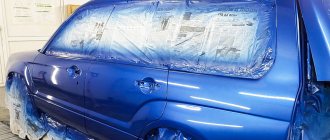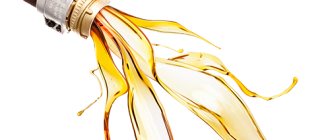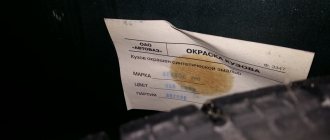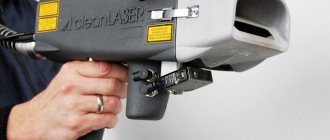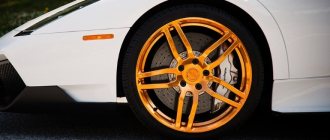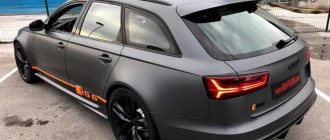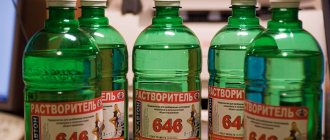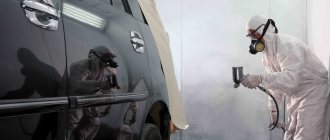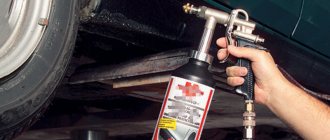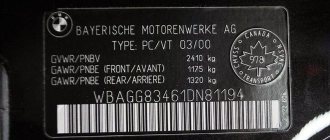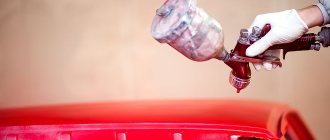Comments: no Published: 01/07/2016
Rating:
Tags:Car paintVarnishes and paint
Painting a car in a showroom is not a cheap pleasure. But you can do it on your own if you practice a little first and become familiar with the basic rules of work. It is also very important to calculate the correct amount of paint that will be needed for your car. Why this is so important and how to find out how much it costs to paint a car completely, you will find out further.
Material consumption for the machine as a whole and for individual elements
It should be noted right away that there is no clear answer to this question. Many factors play a role here:
- manufacturer of coatings,
- hiding power of paint,
- selected color,
- the size of the element or the car itself,
- color of the substrate or primer,
- transfer coefficient of the spray gun, etc.
Therefore, we will operate with approximate figures. For an average part: wing, door, etc., the enamel consumption is 150 ml, for a bumper you will spend, depending on its size, about 250-300 ml, for the hood you will spend about 400-600 ml of dye.
From this we can conclude that at 1 m? Approximately 200-250 ml of paint and varnish are spent. The varnish consumption is exactly the same (if you do not take into account the hardener and thinner). But provided that you apply it in 2 layers.
The material consumption depends, of course, on what car painting technology you chose, on the thickness of the layers and their number. In general, a medium-sized car (sedan) requires about 2 liters of base and the same amount of varnish. All figures are for materials undiluted. In other words, the hardener and solvent are not taken into account here.
Now to the question of how much paint is needed to paint a car, based on its type. You will need about 2 liters of acrylic composition. An average car will need about 3 liters of alkyd enamel. It should be said that this is only consumption on the outside of the body. If you are going to paint it inside, then the cost of paintwork materials will increase to 4 liters.
How to calculate the consumption of paint and varnish?
To calculate how much paint or varnish is needed to paint a car or its parts, you can use the average rate. According to approximate calculations per 1 sq.m. body, ¼ liter is spent. material. It follows from this that a vehicle will need 3.5 - 4 liters of paintwork.
As for the varnish, its consumption will be the same as the coloring composition (for a two-layer coating, the amount of substance must be multiplied by two). The amount of varnish also depends on the covering power of their base. Taking this parameter into account, in order to save on consumption, it is better to choose compounds made from synthetic resins. Nitro-combined and acrylic analogues “cover” the paint worse.
How long does spray paint last?
The question of what area of the car is enough for a 150-gram can of paintwork also does not have a clear answer. For example, manufacturers indicate a very wide range of this parameter: from 0.25 m? up to 0.5 m?. But manufacturers of paints and varnishes cannot give an exact answer, since the amount of consumption largely depends on you.
The cost of the composition will be significantly lower, for example, if the base is finely porous and well polished. This will also be facilitated by the fact that the color of the repaired area of the body matches the paint being applied as closely as possible. The consumption of varnish and paint may also depend on their temperature; too cold paint and varnish forms flowing “tears”.
Material costs are also optimal when old, well-sanded varnish is treated with paint of the same color.
The minimum consumption will be if a light coloring composition is applied to a gray-black base or dark paint to a white base, in this case their covering power will be justified.
But the situation with a light yellow dye on a dark primer is much more complicated, because here the covering ability of the corresponding pigment also plays a crucial role. Among other things, under the same conditions of body surface treatment, aerosol cans, even from the same manufacturer, may not have the same covering power.
Painting rules
We have already said that product consumption is affected by weather conditions, location of work, etc. Here are some important rules:
- the temperature of the air, painted elements, paint and varnish should be at the same level;
- You cannot heat the paint or elements of your car before painting it;
- sufficient time will allow you to avoid drips;
- In order for the paint to lay evenly, you need to use a “sticky napkin”, which will remove particles of debris and dust;
- wear a special suit and face mask
During work, adhere to painting technology so as not to waste material.
If you practice a little on old parts, you will realize that painting is not difficult. After a successful upgrade, all that remains is to thoroughly polish the car and you can get behind the wheel again!
Author: Ekaterina
Machine size
Of course, the larger the car, the more paint you will need to paint it.
p, blockquote 4,0,0,0,0 —>
p, blockquote 5,0,0,0,0 —>
For example, to paint a small subcompact car you will need less than 2 liters of undiluted paint, while painting an SUV with a large body area will require more paint. It is also necessary to consider whether the openings will be painted. This will also increase paint consumption.
p, blockquote 6,0,1,0,0 —>
How much spray paint will you need?
Paintwork in cans is indispensable for small-scale repair work. Manufacturers declare its consumption:
- 150 ml is enough to paint 0.25-0.5 m² of surface in 1 layer or an area of 0.25-0.38 m² 2 times;
- 400 ml can be painted on an area of 0.65-1 m² in 2 layers.
The consumption of aerosol paint depends on the skill of the master and the same factors as when processing other types of paintwork on the body.
There is a special acrylic paint for wheels that improves the appearance of the entire car. It is applied 2 times. For 4 discs, 2 400 ml cans are enough.
Paint color and original body color
p, blockquote 7,0,0,0,0 —>
The amount of paint required to paint a car depends on what color the car will be painted and what the original color of the surface to be painted is. If the body panel has a color contrasting to the one being sprayed, then more paint will be needed. Colors such as yellow, red, and blue are low opaque, so more paint may be needed to cover the original color. If the paint has low coverage, then it is necessary to apply more layers to paint the substrate. For example, when painting with red and yellow paint, up to 10 or more layers may be required.
p, blockquote 8,0,0,0,0 —>
Colors such as black, white, and bright green have good hiding power.
p, blockquote 9,0,0,0,0 —>
If a car is repainted due to numerous minor defects and scratches that are sanded off during preparation of the body for painting, then less paint will be used than when changing the color of the car.
p, blockquote 10,0,0,0,0 —>
The color of the substrate will affect the final shade of the paint.
p, blockquote 11,0,0,0,0 —>
Note: Hiding power is the ability of paint, when sprayed, to completely cover the color of the surface, that is, to cover the color of the substrate with the sprayed color. Thus, the more opaque the paint, the less it will be needed to paint the part.
p, blockquote 12,0,0,0,0 —>
How much paint do you need to paint a VAZ 2106
It is impossible to say exactly how much paint will be spent on painting a car, but there are basic principles that will help you understand the cost of paint when painting the body of a car.
The amount of paint is affected by:
- Machine size
- Paint color and original body color
- Paint quality
- Spray type
- Artist Experience
Let's take a closer look at each item.
Of course, the larger the car, the more paint will need to be applied.
For example, painting a small subcompact requires less than 2 liters of undiluted paint, while painting a larger SUV will require more paint. You also need to consider whether the holes will be painted. This will also increase paint consumption.
The amount of paint needed to paint a car also depends on what color the car will be painted and what the initial color of the painted surface will be. If the body panel has a contrasting color with the coating, then more paint will be left accordingly. Colors such as yellow, red and blue are a bit opaque, so more paint may be needed to cover the original color. If the paint does not cover much, you will need to apply a large number of coats to apply the undercoat. For example, red and yellow colors may require up to 10 or more layers.
Colors such as black, white, and bright green have good hidden ability.
If the car is being repainted due to numerous small defects and scratches that are sanded down when preparing the body for painting, then the paint will not go as well as when changing the color of the car.
READ How to Check the Oil in a Grant Box
Complete car painting for 3.5 thousand. from the pelvis to the vases there are 4 parts. Restoration Lada.
The color of the substrate will affect the final shade of the paint.
Notes: Hidden power. This is the ability of a paint to completely cover the color of a surface when sprayed, in other words, to cover the color of the substrate with the color being sprayed. Thus, the more opaque the paint, the less paint will be needed to paint the part.
Paints from different manufacturers may have different compositions and, accordingly, different covering abilities.
High-quality opaque paint can cover the substrate in 2-3 layers.
The paint spray device has a significant impact on paint consumption. HVLP sprayers have a high percentage of transfer of paint material to the surface being painted. For high quality HVLP sprayers this percentage is over 75%. Painted with such aerosols, the paint reaches maximum parts and does not fly around.
From personal experience I can say that when I take high-quality paint in the amount recommended for painting the parts I need, the paint often remains (sometimes more than half). I paint using an Iwata W-101 sprayer purchased from an official representative. Based on my own experience, I am convinced that a high-quality, economical gun significantly reduces paint consumption.
The amount of paint required to paint the car body also depends on the professionalism of the car dealer. An experienced artist will position the spray gun correctly and draw correctly. The paint should not be applied as dust, and when it hits the surface, it should be well distributed. It would be wiser to cover first repair areas and replaced body panels that are a different color from the rest of the body. Next, you can begin to gradually color all parts of the body.
READ How to Remove Kalina Dashboard
If the car is painted with a paint that needs additional clearcoat, it may require more clearcoat than the base paint. The varnish must be of a certain thickness because it is a protective coating. For example, if the body paint requires about 2 liters of base paint, the varnish may require 3 to 3.5 liters. Even if there is less varnish, it is better to take it with a reserve and not dilute it all at once, but as an expense. The remaining undiluted varnish will be useful later when painting any car.
As a rule, the amount of varnish depends on the area of varnish, and not on the amount of base paint. The amount of paint and varnish can be the same.
From 100 to 300 grams of undiluted paint is used on the body panel. The bumpers, hood and roof of the car are larger than the rest of the body, and painting takes twice as long.
Please note that some parts need to be painted on both sides (top or lid).
If you use paint sparingly, you may need 2 kg of paint for the entire car. Varnishes are needed in approximately the same quantity.
READ How to Adjust a Spray Gun for Painting a Car
Basically, 2-2.5 kg of undiluted paint is enough to paint a four-door car. Since the base paint is diluted from 1 to 1 (1 liter of April (mixed with 1 liter of thinner), then the diluted paint will receive twice as much.
If you need to paint a car with all the openings, you will need 0.5 per paint. 1 kg. Since the base paint is usually thinned 1 to 1, the amount of paint sprayed for spraying will be 2 times as much.
- You should always buy more paint and varnish than you may need. The remainder can be stored until the next repair. Leftover virgin ink can be stored by tightly sealing the container. It does not contain a hardener and will be stored for a long time. Even if the paint thickens after a while, it can always be thinned with thinner. Before applying varnish, dilute half of the varnish you purchased and, if necessary, dilute additional varnish.
- It should be remembered that base paint and two-component acrylic are diluted with different thinners. If the base paint (which requires further varnishing) is diluted with universal acrylic thinner, defects may occur during painting, especially when painting metallic and pearlescent.
Share the post “How much paint does it take to paint a car?”
Source
Painter experience
The amount of paint required to paint a car body also depends on the professionalism of the car painter. An experienced painter will set up the paint gun correctly and distribute the paint correctly. The paint should not be applied in the form of dust, but should spread well when it hits the surface. It is wiser to first paint over repair areas and replacement body panels that are a different color than the rest of the body. Then you can proceed to the step-by-step painting of all body parts.
p, blockquote 18,0,0,0,0 —>
Preliminary work to prepare the car for painting
Directly painting a car with your own hands takes 1/10 of the time spent on the entire operation, and the remaining 9/10 is occupied by preparatory work for painting. They represent the following sequence of actions:
- The first step is to clean the car from dirt, dust and grease stains using detergents and white spirit. Gasoline and solvents should not be used for this purpose.
- Then you need to remove from the body all parts that may interfere with painting. To do this, both bumpers, all headlights, the radiator grille, all devices for outdoor lighting, and antennas are removed.
- The next step is to clean up surface defects on the body. In good lighting, dents, chips, and scratches on the car's surface are identified and marked. Using a chisel and sandpaper, clean the marked areas to the metal surface. After completing the operation, remove dust again using a piece of cloth soaked in white spirit.
- Next, the surface is primed with a two-component acrylic primer, and all defects are puttied with polyester putty and primed again.
- We sand the primer with sandpaper and move on to painting.
Base paint + varnish
If the car will be painted with paint that requires further varnish, then more varnish may be required than base paint. It is necessary to create a certain thickness with varnish, since it is a protective coating. For example, if it takes about 2 liters of base paint to paint the body, then 3 – 3.5 liters of varnish may be required. Even if a smaller amount of varnish is used, it is better to take it in reserve and dilute it not all at once, but as it is used. The remaining, undiluted varnish will be useful in the future when painting any car.
p, blockquote 19,0,0,0,0 —>
In general, the amount of varnish depends on the area to be varnished, and not on the amount of base paint. The amount of paint and varnish may be the same.
p, blockquote 20,0,0,1,0 —>
Determine how many liters of paint are needed to paint a car. Tips and approximate figures.
Whatever type of painting work you perform, be it a complete repainting of a car or a local type of repair, in any case you will be faced with the problem of selecting the necessary consumables. One of the most frequently asked questions that interests many is how much paint and varnish does it take to paint a car? After all, the final price of the work depends on the volume of these materials, and paint and varnish for cars are quite expensive, so no one wants to waste extra money. It is worth noting that you will not be able to guess the volume of material 100%, but it is quite possible to reduce the remainder.
The amount of paint required to paint the entire car
If you use paint economically, you may need 2 kg of paint for the entire car. You need about the same amount of varnish.
p, blockquote 23,0,0,0,0 —>
p, blockquote 24,0,0,0,0 —>
Basically, 2–2.5 kg of undiluted paint is enough to paint a four-door sedan. Since the base paint is diluted 1 to 1 (1 liter of paint is mixed with 1 liter of thinner), you will get twice as much diluted paint.
p, blockquote 25,0,0,0,0 —>
If the car needs to be painted along with all the openings, then you will need 0.5 - 1 kg more paint. Since the base paint is usually diluted 1 to 1, the amount of paint diluted for spraying will be 2 times greater.
How much paint does it take to paint a car? Tuning vehicles costs money, and all owners want their car to meet all the requirements. You can paint the body yourself if you have experience working with materials, the skills to calculate a sufficient volume, and select the appropriate substance.
For finishing in the garage, a base is used that is varnished. Acrylic enamels have a good shine due to their composition, so they can be varnished as desired. It is more difficult to work with red, yellow, and blue colors - you have to apply several layers to paint over the original shade.
The right choice of paintwork
To paint a car, owners choose not only the color scheme, but also the preferred type of enamel. In each case there will be noticeable advantages and disadvantages. Professionals recommend not skimping on paint quality, giving preference to alkyd, acrylic compositions or nitro enamels. The last option is the most popular, because it is applied in several layers, and on top of the hardened finishing coating it is necessary to open it with a protective varnish, which increases the durability of the decorative treatment.
Acrylic and alkyd products are effective when they are made in a two-component format. The manufacturer includes a container with solvent and hardener in the kit, which must be mixed in precise proportions before repainting the car. When sprayed with a spray gun, alkyd compounds are laid on the surface of the body more evenly than their analogues. However, their disadvantage is that they take longer to dry and are more expensive than the other two types.
Less experienced craftsmen prefer spray paint. It leaves virtually no smudges and is distributed fairly evenly on stamped surfaces of any shape. We recommend choosing safe products from popular brands that have been producing safe paint for many years:
- KUDO;
- DUPONT;
- SIKKENS et al.
The choice will have a positive effect on the durability of the coating and minimize consumption. It is known from experience that this composition has better adhesion and a more uniform distribution over the area.
What to consider when calculating
Automotive paint is expensive, so materials are calculated. If you don’t buy enough ingredients, you’ll have to buy more, but the shade will be different.
The following parameters are taken into account:
- Car size.
- Color of parts and paint.
- Quality of material.
- Model of a spray gun.
- Professional skills.
Hiding power is the ability of the composition to cover the original shade of the surface.
- A small runabout will require up to 2 liters of solution, an SUV will require a lot of paint, and finishing openings increases consumption.
- The initial color affects the amount of finishing materials.
- Consumption increases if the shades are contrasting.
- The number of layers increases if the paint has low coverage.
- Red and yellow are often applied up to 10 times.
- White, black, bright green have high hiding power.
- Restoration will require less finishing materials than changing color.
Each manufacturer creates mixtures using its own technology, so the composition may vary.
The model of the spray gun affects the consumption; HVLP devices transfer mixtures well to body parts; for high-quality devices this figure corresponds to 75%. All liquid gets onto the part and does not scatter to the sides.
Consumption is determined by the experience of the painter, who knows how to set up the spray gun and dilute the mixture. Materials flow over the surface rather than settling on it like dust. First of all, restored areas and new body elements are processed, then stage-by-stage finishing is carried out in other places.
We determine the paint consumption for painting a car. Table for calculating the required volume of material.
When you paint a car yourself, you save a lot of money, which is why many people are interested in the question of the technology for carrying out all the work. But one of the main questions that worries novice car painters is: “What is the paint consumption for a car?” Paint is not a cheap material at all, and you don’t really want to buy too much; you’ll end up throwing money away. You will not be able to get an exact answer to this question, since many factors influence the volume of material.
What affects consumption?
At first glance, the main parameters include the surface area that needs to be processed and the number of layers of material that are planned to be applied.
But in fact there are other factors.
- technology of applying the material by a master. This includes the ability to spray an even layer of material without overspray.
- thickness and number of paint layers.
- type of paint and its parameter such as surface coverage.
- paint viscosity. If the paint is diluted too little with solvent, it will be viscous, and the dried surface will have a shagreen effect. If the material is heavily diluted, there is a high probability of smudges. The best solution, if possible, would be to use a viscometer and strictly follow the instructions provided by the manufacturer.
- color and quality of the prepared surface. This step can also significantly reduce your car's paint costs. A well-sanded P800 - P1000 primer surface and a good primer that matches the basecoat tone can reduce the number of coats of paint applied and save you money.
- spray gun settings. Here, first of all, there is a question of choosing the diameter of the nozzle and the uniformity of air supply from the compressor. It is advisable to first try to apply a layer of material on a test surface, and then begin finishing the car.
- temperature of the working environment in the room.
In particular, many craftsmen recommend the use of primers, paints and varnishes from the same manufacturer. This way, you can avoid defects and save on car paint consumption for all sorts of alterations.
Which paint should you choose for your car?
In fact, there are several different types of auto enamels that are used to apply to the car body at home.
How to make the correct calculations for varnish and paint
The above factors and manufacturer's advice affect the consumption of mixtures during operation. Solvent is added to the undiluted base before carrying out work.
- The volume of solvent is 20% of the base, but each type of enamel has its own proportions.
- Average figures for finishing are 200-250 ml of enamel and the same amount of varnish.
- A passenger car requires approximately 3 liters, and a gazelle – up to 5 liters.
- When painting elements on 2 sides, you will need 2 times more mixture.
- Acrylic is consumed 60% less than alkyd.
Paint consumption in cans
An economical option when painting a car is a can of automotive enamel. In addition, using a can is very convenient when painting individual parts.
In this situation, as in the case of ordinary paint, there are only approximate cost estimates. The table shows approximately how much varnish and spray cans are needed for painting different car parts.
| Detail | Aerosol quantity | varnish |
| Front, rear bumper | 3 pcs. | 350 ml. |
| Front, back door | 3 pcs. | 250 ml. |
| Roof | 4 things. | 400 ml. |
| trunk lid | 3 pcs. | 300 - 400 ml. |
| Hood | 3-4 pcs. | 400 ml. |
| Wing (front, rear) | 2 pcs. | 250 ml. |
| Threshold | 1 PC. | 100 ml. |
| Trunk lid hatchback, jeep | 3 pcs. | 300-400 ml. |
| Side racks | 1 PC. | 100 ml. |
| Side mirror | 1 PC. | 100 ml. |
Taking into account all the above nuances when painting a car, you can reduce the likelihood of overuse of paint and calculate the approximate amount of material required. Of course, the main criterion for paint consumption is the size of the machine and the viscosity of the material itself.
